If you want your urban jungle to feel like just a jungle, you must have an indoor climbing plant to complete the look. Vines falling from hung planters, or long tendrils heading up a trellis will add texture to your indoor garden décor and may become a focal point in the scheme of things.
Depending on the amount of light your garden corner receives, you’ll want to choose your climbing plant by the amount of light it requires.
Indoor trailing plants require a little work in the pruning department, especially if you’ve got a rapid grower on your hands. Clipping vining houseplants once in a while will encourage fuller growth. These plants are generally pretty vigorous growers, even if you forget to water them occasionally.
For low-light conditions, any variety of Pothos will provide a lush cascade down from a high perch. If you have a bright sunny spot, both Jasmine and Ivy plants are sun lovers.
Best Indoor Climbing Plants
1. Arrowhead Plant (Nephthytis)
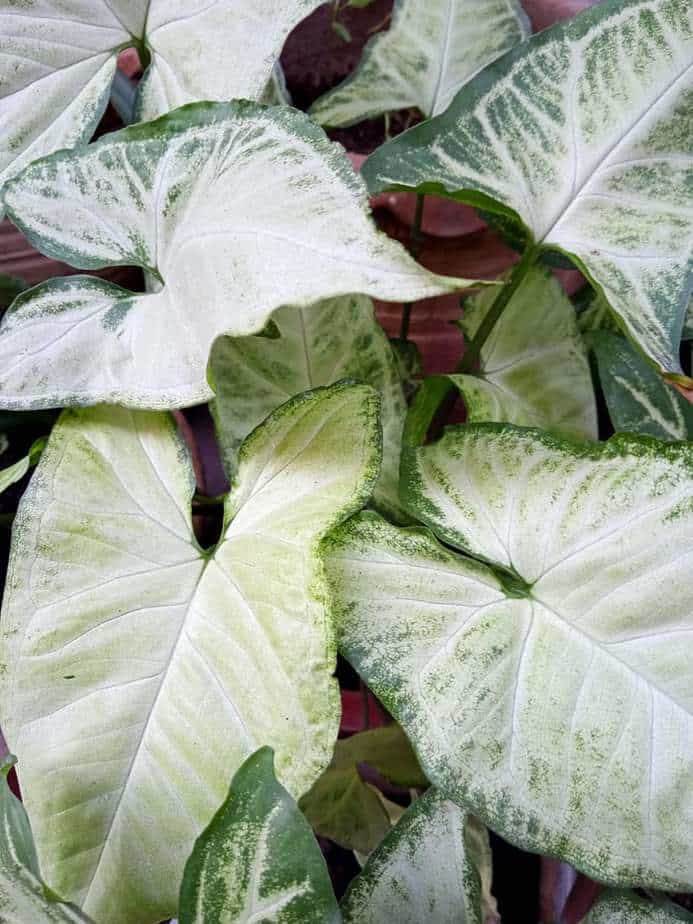
Arrowhead plants tend to trail more than climb, but they can move upward in various directions.
Native to Latin America, they love humidity and moist soil. Soil should never be allowed to become waterlogged or soggy, but water it if the top of the soil bed begins to dry out.
Although the Arrowhead will do fine in medium light, they will thrive in bright indirect light. If the light is low, the foliage will lose variegation and revert to solid green. These leafy plants are glorious year-round.
2. Black-Eyed Susan (Thunbergia plata)
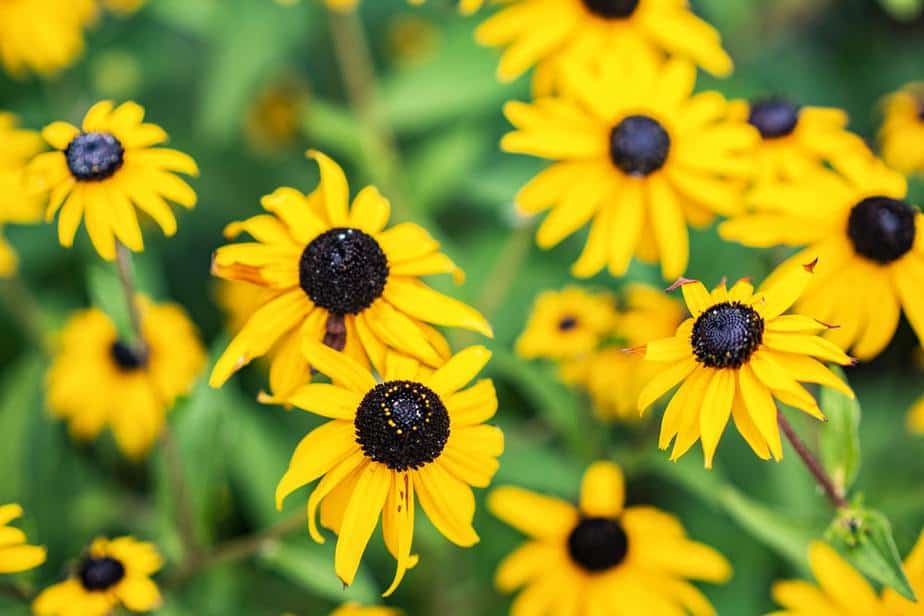
If you love blooming plants, the Black-eyed Susan vine plant can liven up any room in your home.
This is a stunning plant with vividly colored flowers in yellow, orange, and red. Thanks to its striking blooms, it will brighten any space and give a cascade of color from a hanging pot or basket.
The Black-Eyed Susan does well in partial shade to full sunlight. Roots and soil beds should be kept lightly moist. They can be placed outdoors in the summer.
3. English Ivy (Header Helix)
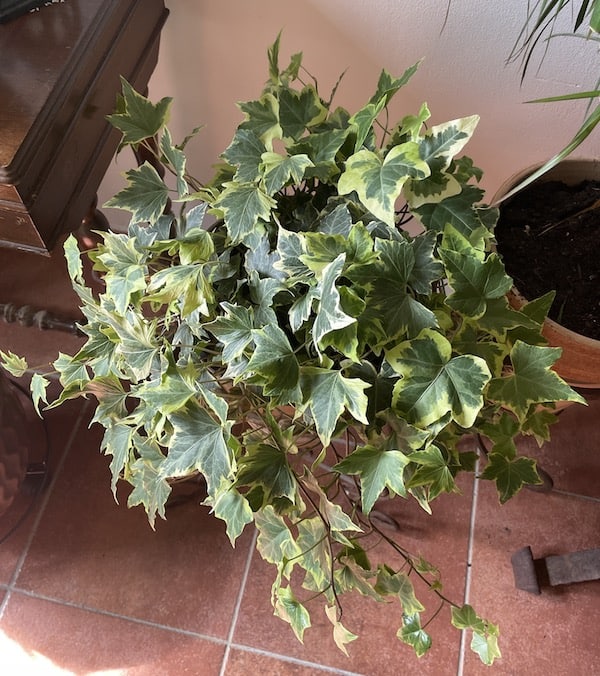
The English Ivy plant is a low-maintenance plant that will adapt to low-light conditions as well as sunnier spots. Moderate medium light is ideal as it will help give it continued variegation in foliage.
At risk of overwatering, the topsoil should be dry at least an inch deep before watering. You can test this by sticking your finger into the soil.
Ivy plants cultivated indoors are not generally wild growers, but with a little training and direction, it can add some flair to your interior design.
4. Golden Pothos (Epipremnum aureum)
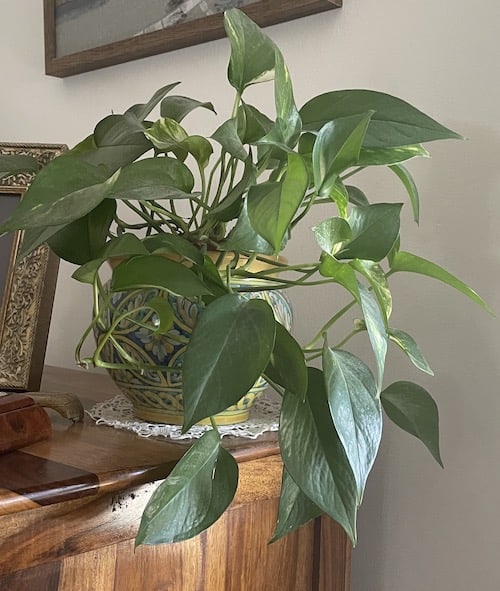
Also known as Devil’s Ivy, the Golden Pothos plant is not only low-maintenance and easy to cultivate, it is difficult to kill. So, if you don’t think you have a green thumb, this plant can prove you wrong or at least keep up appearances.
These indoor plants can adapt to just about any environmental condition and can grow in soil or water. They do very well in high humidity but will adapt to dryer conditions too.
They should, however, not be placed in direct sunlight as leaves will scorch. When leaves droop, they need to be watered. A general rule would be to water once a week, and it is better to underwater than overwater pothos plants.
If you give it indirect bright light, the Pothos will grow attractive variegated leaves.
5. Heart Leaf Philodendron (Philodendron Hederaceum)
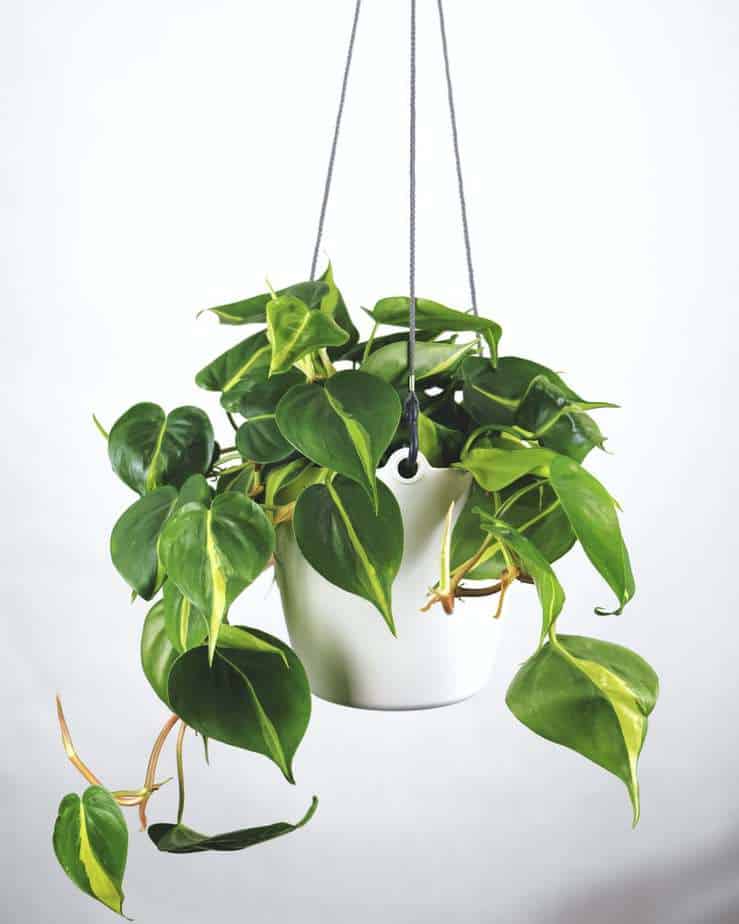
Another vining plant that is easy to cultivate is the Philodendron plant with its heart-shaped leaves. These are rapid growers that will adapt to various lighting conditions, from bright indirect sunlight to low-light situations.
There are several varieties, but the classic Heart Leaf Philodendron is particularly good for low-light environments with its solid dark green foliage and trailing stems.
This plant likes humidity and will require watering when a good half of the soil bed feels dry to the touch. Keep in mind that these plants are toxic if you have pets.
6. Jasmine (Jasminum polyanthum)
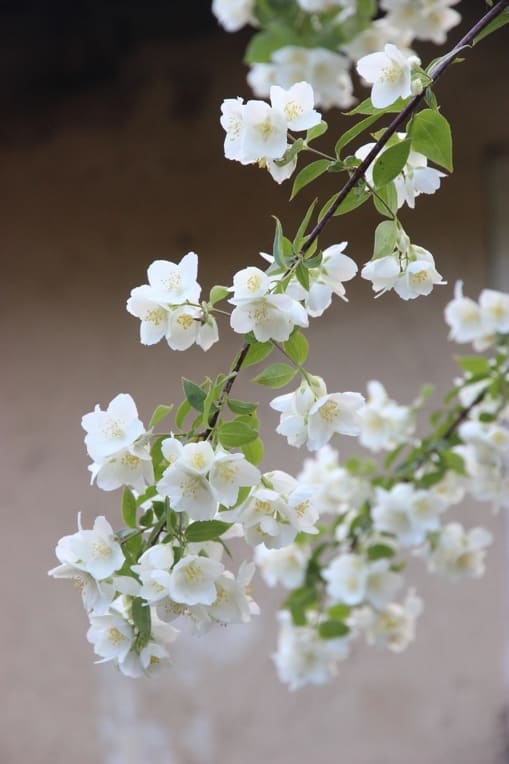
The Jasmine is a sweet-smelling vining and flowering plant that needs several hours of direct sunlight to thrive. Jasmine can be more of a challenge to grow than other climbing plants.
They are prized for their delicately perfumed blossoms that are framed in dark green foliage. Growth is robust and spreads as much as they climb.
Ideally, indoor jasmine should be placed in or near a south-facing window for better growth. They will need something for support as a climbing plant, such as a trellis.
In the summer, Jasmine can be placed outdoors. They do appreciate cool autumn temperatures to produce flower buds that will then blossom generally in February.
7. Strings of Hearts (Ceropegia woodii)
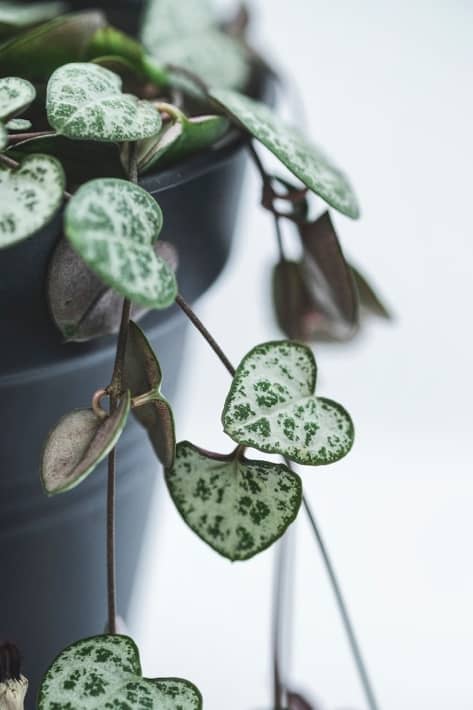
The String of Hearts is a super cool vining plant thanks to its uniqueness. It’s not as common as other plants, and will probably cost a bit more.
The String of Hearts grows quickly and produces tiny variegated green heart-shaped leaves. These vines grow in bright, indirect light. The soil bed should be allowed to dry out between watering. This plant will go dormant during the winter months.
Vines look great when arranged in coils or allowed to drop down as a hanging pot or basket plant.
8. Strings of Pearls (Senecio rowleyanus)
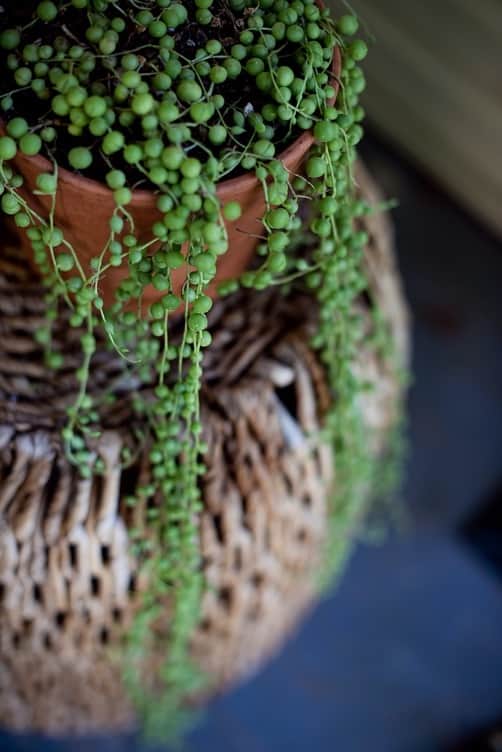
Long thin stems with juicy round beads characterize this fascinating, quirky vine. The String of Pearls is a succulent plant meaning it must have sun and not be overwatered.
Excellent drainage is mandatory for this plant’s health. Vines can grow pretty fast and form new beads with proper care.
String of Pearl plants are beautiful and interesting plants that can easily be attention-getters, but like the gems, should be handled gently.
9. Trailing Jade (Peperomia Rotundifolia)
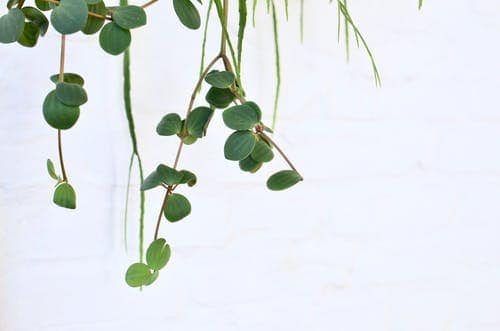
The Trailing Jade plant is a low-maintenance, non-toxic indoor climber. Peperomias are not succulents despite their thick fleshy foliage.
Peperomia plants appreciate medium light and will require more water than succulents. Even so, they should not be overwatered. Water when the topsoil feels dry.
These vines are easy to propagate with either stem cuttings or leaf cuttings, meaning you can gift them to friends and family.
10. Wandering Jew (Tradescantia zebrina)
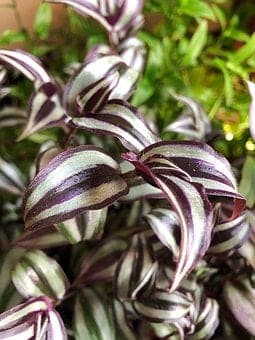
Also called the Inch Plant or Purpleheart, the Wandering Jew plant vines are striped, as if zebra-patterned.
They require very little care and the only need is to keep the soil moist, but they will not do well in waterlogged soil.
Beautifully suited for hanging and cascading downward, they thrive with lots of indirect, bright natural light. They need to be pinched back frequently to prevent stems from looking bare.
The Wandering Jew plant does not have a long lifespan, but can be easily propagated with stem cuttings.
Can You Train a Vining Plant?
Yes, you can and should train vining plants. Training a vining plant simply means giving it direction.
If you want to achieve a specific design or create an effect, you’ll want to train how the vines climb.
This is easily accomplished with plants that hang from baskets or wall hangers. You can direct those stems in a specific direction depending on their positioning.
Viners can trail from just about anywhere. You can allow flowing vines to hang over objects or find support by resting on various objects.
Picture frames and mirrors are ideal for this. They allow a vining plant to flow down the side of a tall piece of furniture or from the top of a bookshelf.
Home Decoration Ideas for Climbing Plants
There are many ways to decorate your home with climbing plants. You want to use climbing plants to use the available vertical space in your home or office.
Here are some ideas:
1. Plant Stands
Plant stands are a furniture accessory, so when selecting one, make sure it matches the style of your interior design. They should complement the space where they are located.
When selecting a stand, make sure that it can support the plant and the plant container, but it should showcase the plant and not steal the show. Look for practicality with style.
2. Shelves
Vining plants look terrific when placing the plant pots on shelves and allowing them to trail down.
They can also break up the look of a shelf that’s just books, especially when used as a bookend.
3. Wall Hangers
Like plant stands, hangers come in all kinds of designs and are made of a lot of different materials.
They can be hooks attached to the wall or can be hung on macramé cords from ceilings in glass vases, ceramic pots, baskets, metal cans, or even wood containers.
4. Climbers and Trellises
Climbing plants benefit from training because they can attach to and climb on walls, trellises, poles, and any type of structure that offers sufficient support.
When used on poles, climbers will need to wrap around these supports. You can use loose ties to give it direction.
Another great decorating idea is to use clear plastic hooks on walls. Viners can be draped on these hooks to create a design or an effect.
Trellises now come in many styles and materials to add some flair to your climber. You can create your own trellis or buy one of the many designs available online or in stores.
Basic Care Tips for Indoor Climbing Plants
Although each plant will have specific characteristics and requirements, generally speaking, indoor vine plants need a well-draining soil bed that is fertile.
Most can be watered when the soil is partially dry. Vine plants can be fed monthly during the growing season and misted occasionally to help with humidity levels.
Most vine plants do well in bright, indirect light but some can easily adapt to lower light conditions.
Temperature and Humidity for Indoor Climbing Plants
Climbing plants do well at average room temperatures. The temperature range should measure between 65° and 85° Fahrenheit.
Generally, plants should be kept away from hot or cold drafts, heating units, air conditioners, and direct sun exposure.
Often, average house humidity is a bit dry, so humidity levels can be increased with space humidifiers, pebble trays, or grouping plants together. Misting will not solve humidity, but will certainly help.
Soil for Indoor Climbing Plants
Because your climbing plant will be cultivated in a container, you need quality potting soil mix. The potting mix should be of good quality and rich in organic matter.
Water for Indoor Climbing Plants
A potting mix should be able to retain moisture, but should not be allowed to become soggy or waterlogged.
You can soak your plant and allow water to drain out completely by leaving your plant in a tub, shower, or sink until completely drained.
Light for Indoor Climbing Plants
Most indoor plants will do well in bright, indirect light. Exposure to direct sunlight can scorch foliage and eventually kill the plant. Some indoor climbers will adapt well to partial shade or low light conditions.
With less light, however, they most likely will not bloom, and colorful leaves can fade with too little light.
Indoor Climbing Plants Final Thoughts
Indoor climbing plants are a fun addition to your home décor. They offer a unique way to bring color and life into your living spaces.
For some decorative flair, get an indoor climber to add texture to your urban jungle. You’ll never regret having done so.
If you’re interested in adding a few indoor climbing plants to your home, then we suggest starting small. Choose a single plant or two, and see how they grow and thrive.
Once you get hooked, you will want to expand your collection!
For more great houseplants, check out these articles:











